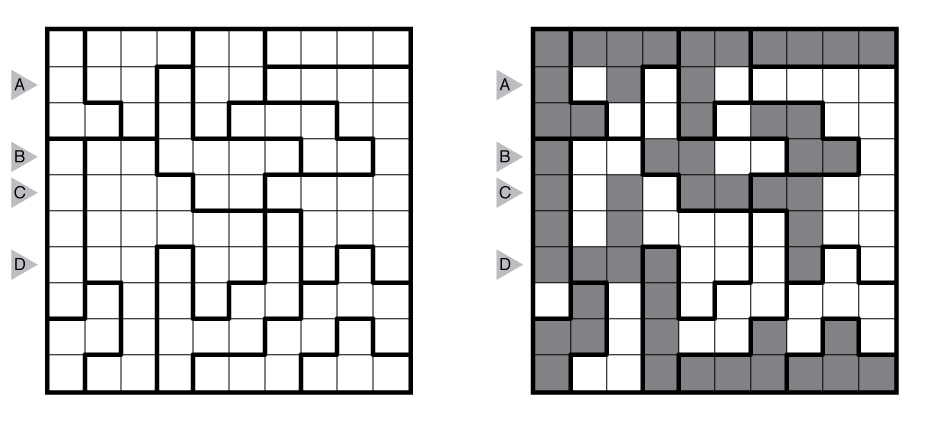LITS Rules and Info

Rules: Shade exactly four connected cells in each outlined region, to form an L, I, T, or S tetromino, so that the following conditions are true: (1) All shaded cells are connected with each other; (2) No 2×2 group of cells can be entirely shaded black; (3) When two tetrominoes in adjacent regions share an edge, they must not be of the same type (L, I, T, or S), regardless of rotations or reflections.
Answer String: Enter the length in cells of each of the shaded segments from left to right for the marked rows, starting at the top. Separate each row’s entry with a comma. This example has the key “111,122,114,41”.
(Brief) History of LITS: LITS was first published in 2004 by Nikoli in quarterly Communication 106; the original name was Nuruomino (ヌルオミノ) from the Japanese word ‘nuru’ meaning “to paint” and from ‘omino’ short for “polyomino”. By 2005 the puzzle was renamed LITS in reference to the four tetromino shapes allowed in the puzzle (the O tetromino, which forms a 2×2 square, cannot be used). The puzzle rose from other shading puzzle types, and certainly took some inspiration from Nurikabe whose black region constraints — (1) and (2) above — are replicated in this style.
History of this example: This “four corners” LITS was written by Thomas Snyder for Grandmaster Puzzles. Besides featuring one simple region for each tetromino type in the corners, it highlights both the connectivity requirement and the no repetition requirement of LITS puzzles.
Sources for LITS Puzzles: Follow this link for classic LITS puzzles on this website and this link for variations on LITS puzzles. If you are new to this puzzle type, here are our easiest LITS Puzzles to get started on. More LITS puzzles can be found in LOTS O’ LITS by Grant Fikes and Prasanna Seshadri, in The Art of Puzzles 2, and in our beginner-friendly collection Intro to GMPuzzles by Serkan Yürekli.
Design rules for contributors: A Grandmaster LITS will have a unique solution that can be reached by logic alone. Generally, a Grandmaster LITS should have an interesting visual theme or an interesting solution. Sizes from 10×10 and above are recommended (maximum aspect ratio of 2:1 if rectangular).
